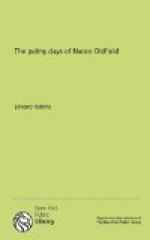The Jacobites could not interfere with the triumph of the “Non-juror,” but they were shrewd enough to bide their time. That time came, as they thought, in 1728, when there was unfolded at Drury Lane a comedy which became famous under the title of “The Provoked Husband.” The rough draft of the play was the work of Vanbrugh, now dead, but the dialogue and situations had been elaborated by Cibber. Here was a chance, therefore, to damn the latter writer, and accordingly the malcontents repaired to the theatre, hissed the performance roundly, and then went home with the comfortable reflection that they had gotten their revenge. Their revenge, however, was shortlived, for the general public liked the comedy, and soon flocked to its rescue.
“On the first day of ‘The Provok’d Husband,’” says the Poet Laureate, “ten years after the ‘Non-juror’ had appear’d, a powerful party, not having the fear of publick offence or private injury before their eyes, appeared most impetuously concerned for the demolition of it; in which they so far succeeded that for some time I gave it up for lost; and to follow their blows, in the publick papers of the next day it was attack’d and triumph’d over as a dead and damn’d piece: a swinging criticism was made upon it in general invective terms, for they disdain’d to trouble the world with particulars; their sentence, it seems, was proof enough of its deserving the fate it had met with. But this damn’d play was, notwithstanding, acted twenty-eight nights together, and left off at a receipt of upwards of a hundred and forty pounds; which happened to be more than in fifty years before could be then said of any one play whatsoever.”
The play was saved, and no one contributed more importantly to that result than did Mistress Oldfield. Her acting as the heroine, Lady Townley, was pronounced superb, and though she had now drifted into middle-age—was she not over forty?—Nance still seemed, on the stage at least, the incarnation of youth and grace. Is there not a certain English actress, now living (one, by-the-way, who plays Nance Oldfield and suggests her as well) who defies the inroads of time with equal carelessness.[A]
[Footnote A: In the wearing of her person she (Oldfield) was particularly fortunate; her figure was always improving to her thirty-sixth year, but her excellence in acting was never at a stand. And Lady Townley, one of her last new parts, was a proof that she was still able to do more, if more could have been done for her.—GENEST.]
Lady Townley is nothing more or less than a glorified, matured edition of Lady Betty Modish, and, therefore, a very charming woman. Charming, at least, on the boards of a theatre, if not upon the floor of a real drawing-room. For she has a love of pleasure which can hardly be called domestic, and her unfortunate husband, who would see more of her, is tempted to ask, in the very first scene of the play: “Why did I marry?” “While she admits no lover,”




